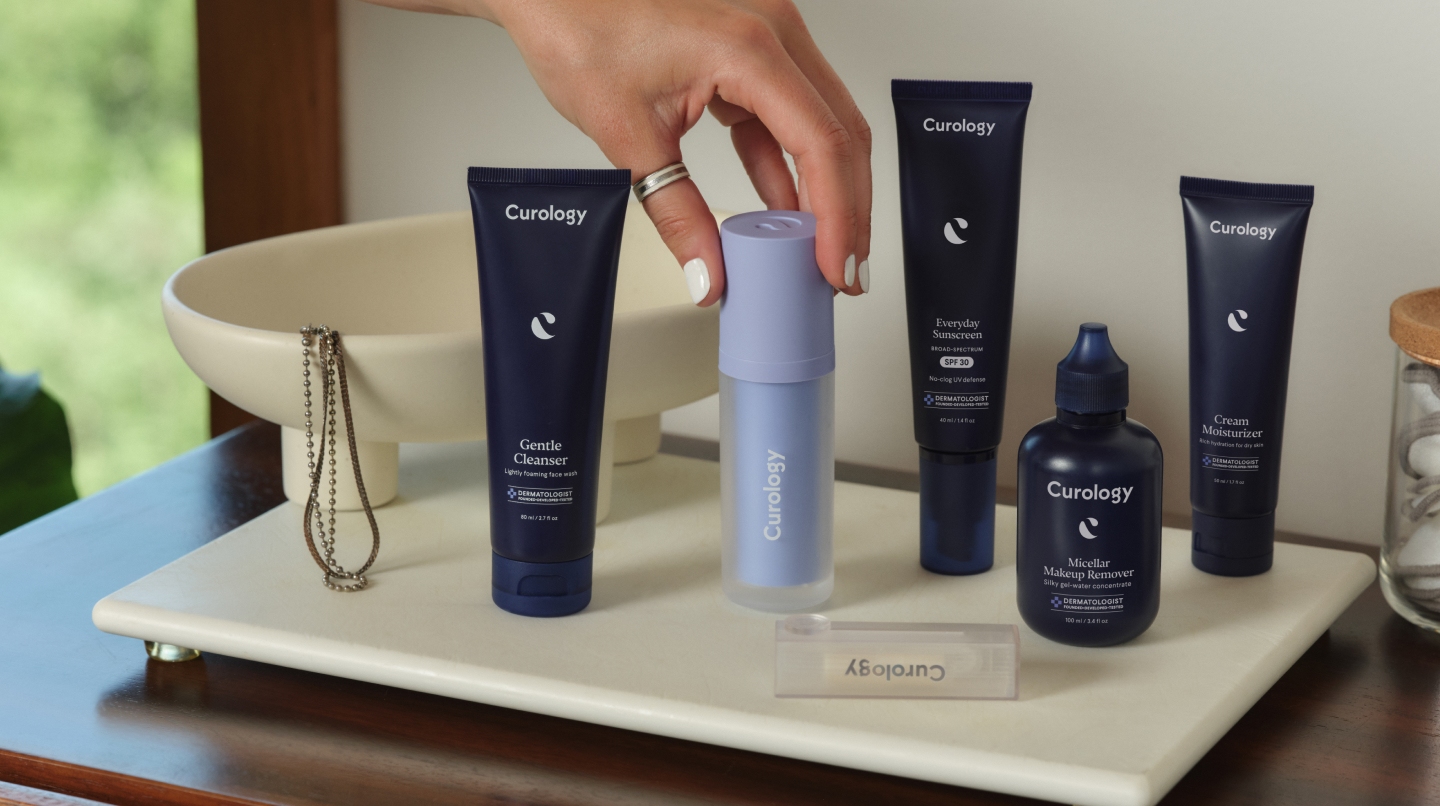How it works:
Share your skin goals and snap selfies
Your dermatology provider prescribes your formula
Apply nightly for happy, healthy skin
How it works:
How it works:
Share your skin goals and snap selfies
Your dermatology provider prescribes your formula
Apply nightly for happy, healthy skin
How it works:
Does dairy cause acne? Here’s what you should know
Going dairy-free may be the ticket to clear skin for some people.



Dairy is a classic cornerstone in many Western diets, and for many, it has a VIP spot on the menu at breakfast, lunch, dinner, and dessert—be it milk, cheese, or ice cream. But did you know for some people, this ever-present ingredient may contribute to acne breakouts?
When it comes to figuring out which foods to potentially avoid, many board-certified dermatologists and dermatology providers recommend starting by giving dairy a break (at least temporarily).
It may seem like a big ask, but here’s why it might be worth it.
Is there a link between dairy and acne?
Recent studies have shown that dairy consumption may—for some people—trigger breakouts.¹ The evidence is convincing, but it’s important to know it doesn’t apply to everyone. Some people break out from consuming dairy products; others don’t.
So if dairy doesn’t cause acne for everyone, how do you determine if your dairy intake is possibly one of the reasons behind your breakouts? Consider eliminating milk, ice cream, and other dairy products to see if your skin clears up, and try dairy-free, low-glycemic alternatives—such as almond milk or soy milk—instead. (For more info on dairy’s potential relationship to acne, check out our guide!)
How does milk affect acne?
Acne may be triggered by hormonal changes in our bodies. Milk, in particular, contains insulin-spiking hormone triggers that can lead to breakouts.² If pimples appear on your jawline, chin, and cheeks, it might be a sign of hormonal acne.
3 dairy products to consider avoiding with acne-prone skin
Many dairy products carry the same risk factors regarding acne, but some may be worse than others. Here are the three biggest offenders when it comes to dairy-induced acne:
Cow’s milk, especially skim and low-fat, may contribute to acne. The same link is not found in full-fat (whole) milk.³ More research is needed, but the risk of breakouts seems to be correlated with total milk consumption—having more than three portions of milk per week may cause more breakouts for some people.⁴
Milk-based ice cream may also be a contributing factor to breakouts. One study showed a positive connection between consuming foods high on the glycemic index and breakouts. A possible explanation for ice cream's link to acne is the combination of high dairy and sugar content. The same study showed that consuming ice cream more than once per week increased the risk of having acne by four times compared to those who did not consume ice cream.⁵
Whey protein is the liquid left over during the cheese-making process. After it’s filtered, dried, and packaged, it is a common component of protein powder. Protein supplements have been shown to cause acne lesions.⁶
Can following a dairy-free diet reduce breakouts?
Possibly, but not necessarily! The foods you consume may or may not affect your chances of breaking out. Some may only see mild acne, while others will experience severe acne. If you’re unsure whether dairy contributes to your acne development, the best way to tell for sure is to try cutting it out of your diet and monitoring for changes in breakouts. Here are a few tips for transitioning from a dairy-rich to a dairy-free diet:
Dairy-free diet plan
If you think dairy might be messing with your skin, here’s how to give the dairy-free lifestyle a try:
Try vegan, dairy-free alternatives. Check your local grocery store to find dairy-free cheese alternatives made from plant-based ingredients such as almond milk or tofu. Most grocery stores offer a wide selection of plant-based dairy substitutes, which means you can still have that daily latte. Just make sure they’re low on the glycemic index (meaning they’re less likely to spike your blood sugar).
Try new things! Ditching dairy doesn’t have to limit your dining options. There are many choices out there for vegans and lactose-intolerant people nowadays. We know that some dairy products are hard to give up, and for many, cheese makes the world go around. Luckily, vegan food manufacturers are hard at work trying to perfect dairy-free cheese. Think of this as an exciting opportunity to try new things and discover which dairy alternatives and brands you enjoy the most.
Monitor changes in your body. As long as you’re eliminating dairy to help achieve clear skin, you might experience even more benefits! Some say we’re all a little lactose-intolerant, although some people definitely have more adverse symptoms than others. When you skip the milk, ice cream, and cheese for a while—even if they’re replaced by dairy-free options—monitor whether you feel a difference. Anecdotally, some people claim to feel less bloated or sluggish after cutting dairy from their diet. It's possible you're so used to eating dairy you don't even realize how it may affect you.
Allow yourself to cheat now and then. Don’t stress if you go off track. It’s okay to occasionally indulge in a scoop of ice cream at a party or a little cheese at a special dinner. The goal is to reduce your intake to help clear your skin, so don’t be too hard on yourself if you treat yourself every now and then. To reduce the chance of future breakouts—especially if you allow yourself the occasional cheat day—apply an effective topical skincare treatment, such as your Curology custom cream, as part of your evening skincare routine.
You do you. Social factors are one of the most difficult parts of any lifestyle change (especially a dietary adjustment). If you decide to share the news with friends and family, remember: You’re doing it for you, not for them. Don’t apologize for requesting vegan or dairy-free options when dining out or ordering in. You’re taking a stand for clearer skin!
How to help get rid of dairy-induced acne?
No matter what might be causing your acne, Curology's licensed dermatology providers can prescribe a personalized formula to help clear it up.*
We’re here to help take the guesswork out of your skincare routine. Licensed dermatology providers work with you to examine your skin, assess your skincare goals, and provide custom treatment options.
To learn more about how to keep your skin clear, healthy, and happy, check out our handy-dandy Guides and the Curology blog. For prescription-strength acne treatment, sign up to give Curology a try!
FAQs
Several studies show that foods that raise blood sugar quickly—white bread, cornflakes, puffed rice, potato chips, doughnuts, and sugary drinks—may increase acne breakouts.⁷ We recommend sticking to a well-balanced diet that’s low on the glycemic index for clearer skin.
This is a complex question because many factors may contribute to acne. When addressing your diet, we recommend beginning by eliminating common culprits, such as dairy and sugar.
The safest bet for beating breakouts on the face is to stick to a regular skincare routine that includes cleansing, moisturizing, protecting, and treating. We also have a few tricks to try to treat and prevent body acne on our blog.
P.S. We did the homework so you don’t have to:
Aghasi, M., et al. Dairy intake and acne development: A meta-analysis of observational studies. Clin Nutr. (June 2019).
Melnik., B. Milk consumption: aggravating factor of acne and promoter of chronic diseases of Western societies. Journal of the German Society of Dermatology. (April 2009).
Adebamowo, C., et al. Consumption of dairy in teenagers with and without acne. Journal of the American Academy of Dermatology. (August 2016).
Di Landro, A., et al. Family history, body mass index, selected dietary factors, menstrual history, and risk of moderate to severe acne in adolescents and young adults. Journal of the American Academy of Dermatology. (December 2012).
https://bmcdermatol.biomedcentral.com/articles/10.1186/1471-5945-12-13
Cengiz, F.P., et al. Acne located on the trunk, whey protein supplementation: Is there any association? Health Promot Perspect. (2017 March 5).
American Academy of Dermatology. Can the right diet get rid of acne? Ibid.
* Subject to consultation. Subscription is required. Results may vary.
Elise Griffin is a certified physician assistant at Curology. She received her Master of Medical Science in physician assistant studies from Nova Southeastern University in Jacksonville, FL.

Curology Team

Elise Griffin, PA-C
Related Articles
How to use acne body wash correctly: Your straightforward guideMen skin care: top concernsHow to get rid of body and back acne?What is micellar water and how can you use it effectively?The science behind our skincare quiz: why it worksPopular Articles
Ask Curology: Is my cold breaking me out?Slugging: The dermatologist-approved skincare hack going viral on TikTokTretinoin vs retinol: What’s the difference?How to create a self-care routine that actually sticksYour 2023 skincare horoscopeTry prescription skincare
Get routine essentials

Good skin days ahead
- Breakouts
- Redness
- Fine lines
- Dark spots
- Hair thinning